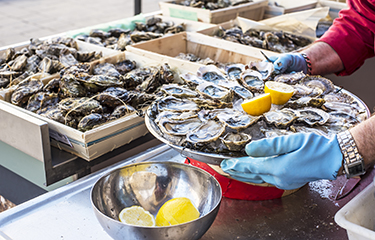The U.S. Food and Drug Administration is stepping up traceability recordkeeping requirements for suppliers of seafood and other fresh foods via the issuance of a new final rule.
The rule is designed to reduce contaminated food through the food supply, whether sourced in the U.S. or abroad.
“FDA will be able to more rapidly and effectively identify the origin and route of travel of certain contaminated foods to prevent or mitigate foodborne illness outbreaks, address credible threats of serious adverse health consequences or death, and minimize overly broad advisories or recalls that implicate unaffected food products,” the agency said in a press release.
The additional recordkeeping requirements apply to those that manufacture, process, pack, or hold certain foods, including all histamine-producing species of finfish, all finfish potentially contaminated with ciguatoxin (such as grouper, barracuda and snapper), and all finfish. The rule also applies to all smoked fish, molluscs, and crustaceans.
Molluscan shellfish means any edible species of fresh or frozen oysters, clams, mussels, or scallops, or edible portions of such species, except when the product consists entirely of the shucked adductor muscle, the agency clarified.
To determine which foods should be included on its food traceability list, the FDA developed a risk-ranking model for food tracing based on the factors the U.S. Congress identified in the 2011 Food Safety Modernization Act.
Data for catfish were excluded from the risk-ranking model because siluriformes fish (such as catfish) are primarily regulated by the U.S. Department of Agriculture, the FDA said.
“This standardized, data-driven approach to traceability recordkeeping helps create a harmonized, universal language of food traceability that will help pave the way for industry to adopt and leverage more digital, interoperable and tech-enabled traceability systems both in the near-term and the future,” FDA Deputy Commissioner for Food Policy and Response Frank Yiannas said.
Key features of the final rule include an expansion of FDA's authority to require companies enact new food-safety requirements, including the identification of citical tracking events at specific points in the supply chain – such as harvesting, cooling, initial packing, receiving, transforming, and shipping foods. FDA may also require the creation of a traceability plan, or information essential to help regulators understand an entity’s traceability program. These include a description of the procedures used to maintain required records, descriptions of procedures used to identify foods on the food traceability list, descriptions of how traceability lot codes are assigned, a point of contact for questions regarding the traceability plan and a farm map for those that grow or raise a food on the food traceability list. Additional requirements FDA can impose include maintenance of records as original paper or electronic records, or true copies; providing requested records to the FDA within 24 hours of a request; and providing records in an electronic sortable spreadsheet when necessary to assist the FDA during an outbreak, recall, or other threat to public health.
FMI, the U.S. food industry association trade group, crticizied the new rule.
“It is already clear that implementation of the requirements in the rule will demand tremendous investments of time and resources across the entire food industry, and it looks like this rule significantly exceeds the statutory authority, both written and intended, by Congress," FMI said in a press release. "FMI and our members work every day to further strengthen the safety of our food supply and the continued rapid removal of any impacted products. This work needs to be done in the most-efficient, consistent manner across all elements of the food supply chain with the least possible impact on food prices, greatest impact on results, and consistency with the intent of the law passed in 2011. Based on our quick review of this incredibly complex rule, it does not accomplish this."
Photo courtesy of Alvaro German Vilela/Shutterstock







